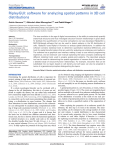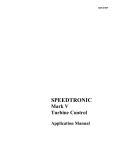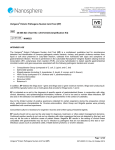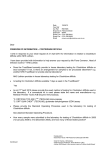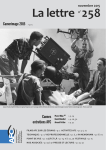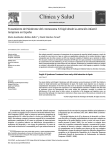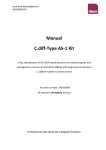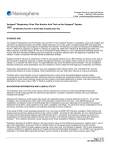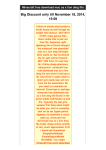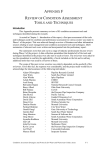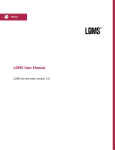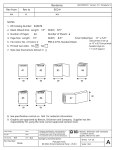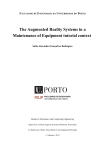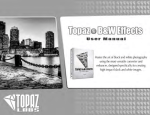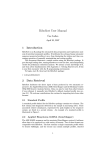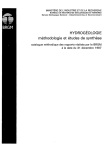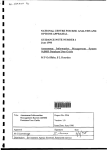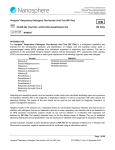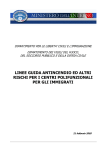Download Verigene CDF Package Insert
Transcript
Customer Service or Technical Service: In the U.S. Phone: 1-888-837-4436 (toll free) OR E-Mail: [email protected] Outside the U.S.: Contact your local Nanosphere distributor i www.e-labeling.eu/NAN022 Verigene® Clostridium difficile Nucleic Acid Test (CDF) 20-005-022 (Test Kit) ● 20-012-022 (Amplification Kit) IVD NAN022 INTENDED USE ® The Verigene Clostridium difficile Nucleic Acid Test (CDF) is a qualitative multiplexed in vitro diagnostic test for the rapid detection of toxin A (tcdA), toxin B (tcdB), and tcdC gene sequences of toxigenic Clostridium difficile and for presumptive identification of PCR ribotype 027 strains from unformed (liquid or soft) stool specimens collected from patients suspected of having C. difficile infection (CDI). Presumptive identification of the PCR ribotype 027 strain of C. difficile is by detection of the binary toxin (cdt) gene sequence and the single base pair deletion at nucleotide 117 in the tcdC gene. The tcdC gene encodes for a negative regulator in C. difficile toxin production. The test is performed on the Verigene System and utilizes automated specimen preparation and polymerase chain reaction (PCR) amplification, combined with a nanoparticle-based array hybridization assay to detect the toxin gene sequences associated with toxin-producing C. difficile. The CDF test is indicated for use as an aid in the diagnosis of CDI. Detection of PCR ribotype 027 strains of C. difficile by the CDF test is solely for epidemiological purposes and is not intended to guide or monitor treatment for C. difficile infections. Concomitant culture is necessary only if further typing or organism recovery is required. BACKGROUND INFORMATION AND CLINICAL UTILITY Clostridium difficile is a gram-positive, spore forming bacillus that can cause mild to severe diarrhea, 1 pseudomembranous colitis, sepsis, and even death. Recently C. difficile infection (CDI) has become more 2 prevalent and more severe worldwide. The colonic flora in a healthy adult generally resists colonization by C. 3 difficile. Yet, CDI among relatively young and healthy individuals are increasing. Antibiotic exposure is an important risk factor for CDI. The most common way to acquire this organism is through a hospital-acquired infection. When exposed to most types of antibiotics the intestinal flora in humans become unbalanced, allowing toxigenic forms of C. difficile that are acquired to proliferate. The toxigenic forms of C. difficile, those that produce toxins A and B (encoded by the tcdA and tcdB genes) within the pathogenicity locus (PaLoc), appear to play a large role in causing disease. Although toxin A is well correlated with pathogenicity, some strains of toxigenic C. difficile do not produce toxin A, but still carry it. The majority of CDIs are caused by toxigenic C. difficile strains that produce both toxins, but there are still cases that involve variants missing toxin A (A-B+). The toxins are pro4 inflammatory enterotoxins, causing the majority of symptoms associated with CDI. The PCR ribotype 027 strain exhibits increased toxin production. This is thought to be a result of a mutation in 5 the tcdC gene, which is also located within the PaLoc, that causes a negative regulation in toxin synthesis. This growth in toxin production is believed to cause an increase in spore production which leads to improved 6, 7 Along with toxins A and B, binary toxin cdt is also produced. Although the role of persistence in the intestines. binary toxin in the pathogenesis is unclear, it is recognized as a virulence factor in the hypervirulent strain. The 8 PCR ribotype 027 strain shows hypervirulence, especially in an outbreak setting. Accurate strain identification is critical for understanding the ever changing epidemiology of C. difficile and for the prevention of future outbreaks 8 in hospitals. The presumptive identification of PCR ribotype 027 strains could potentially assist in early detection, Page 1 of 29 ® Verigene Clostridium difficile Nucleic Acid Test (CDF) 027-00035-01, Rev. A; December 2012 Customer Service or Technical Service: In the U.S. Phone: 1-888-837-4436 (toll free) OR E-Mail: [email protected] Outside the U.S.: Contact your local Nanosphere distributor i www.e-labeling.eu/NAN022 and prevention of a PCR ribotype 027 outbreak, and may aid in the identification of possible sources of a hypervirulent outbreak. Traditionally, cell cytotoxicity assays and enzyme immunoassays (EIA) have been used to detect CDI-causing C. difficile. Cell cytotoxicity assays provide sensitive results, but are labor intensive and time consuming. EIAs, on 9 the other hand, typically have low sensitivity. Comparatively, molecular testing has demonstrated high accuracy 10 and expedient assay turnaround times allowing for higher rates of C. difficile detection in a clinically meaningful 11 timeframe. PRINCIPLES AND PROCEDURES OF CDF AND THE VERIGENE SYSTEM CDF is performed using the Verigene System, which is a bench-top sample-to-result molecular diagnostics workstation consisting of two modules: the Verigene Processor SP and the Verigene Reader. The Verigene Processor SP automates CDF sample analysis steps including: (i) Specimen Preparation - magnetic bead-based bacterial DNA extraction from prepared stool specimens obtained from patients; (ii) Target Amplification – multiplex PCR-based amplification to generate specific amplicons; (iii) Hybridization – amplicon hybridization to target specific capture DNA in a microarray format and mediator and gold-nanoparticle probe hybridization to captured amplicons. Silver enhancement of the bound gold nanoparticle probes at the capture sites results in gold-silver aggregates that are assessed optically with high efficiency by the Verigene Reader. The Verigene Reader also serves as the user interface and central control unit for the Verigene System, storing and tracking information throughout the assay process. The Verigene Processor SP utilizes single-use consumables to perform CDF, including an Extraction Tray, Amplification Tray, and Verigene Test Cartridge. A separate Tip Holder Assembly contains two pipette tips that are used to transfer and mix reagents during the assay. The user tests a specimen by loading the single-use disposables into the Verigene Processor SP, pipetting the prepared specimen into the Extraction Tray, and initiating the protocol on the Verigene Reader by scanning or entering Test Cartridge ID and specimen information. Following assay completion, the user inserts the Test Cartridge into the Verigene Reader for optical analysis and generation of CDF test results. Page 2 of 29 ® Verigene Clostridium difficile Nucleic Acid Test (CDF) 027-00035-01, Rev. A; December 2012 Customer Service or Technical Service: In the U.S. Phone: 1-888-837-4436 (toll free) OR E-Mail: [email protected] Outside the U.S.: Contact your local Nanosphere distributor i www.e-labeling.eu/NAN022 MATERIALS PROVIDED ® Verigene CDF Nucleic Acid Test Kit (Catalog number 20-005-022) ® • 20 Verigene CDF Test Cartridges Each Test Cartridge comes preloaded with all required reaction solutions, including wash solutions, oligonucleotide probe solution and signal amplification solutions required to generate a test result. The Test Cartridges are labeled as: CDF; 20-006-022 • 20 Verigene CDF Extraction Trays (with Tip Holder Assemblies) Each Extraction Tray comes preloaded with all required solutions, including lysis/binding buffer, wash solutions, and buffer solutions necessary to extract nucleic acids and generate a test result. The Extraction Trays are contained within a carrier labeled as: CDF; 20-009-022 • Verigene CDF Stool Preparation Sample Kit Each Kit contains 20 tubes containing CDF Stool Prep Buffer (SPB) and 20 swabs packaged in a resealable bag. The Kit is labeled as: CDF; 30-001-022 ® ® Verigene CDF Amplification Reagent Kit (Catalog number 20-012-022) ® • 20 Verigene CDF Amplification Trays Each Amplification Tray comes preloaded with all required solutions, including enzymes and buffers necessary to amplify nucleic acids and generate a test result. The Amplification Trays are contained within a carrier labeled as: CDF; 20-011-022 MATERIALS NEEDED BUT NOT PROVIDED Instruments and Equipment ® • Verigene Reader; Catalog number 10-0000-02 ® • Verigene Processor SP; Catalog number 10-0000-07 • 2-8°C Refrigerator • ≤ -20°C Freezer • Micro-pipettors & filtered tips • Vortex • Microfuge • Sterile paddles • Decontamination Wipes/Spray or comparable sanitizer REAGENT STORAGE, HANDLING, STABILITY CDF Test Component Storage Conditions Comments Stool Prep Buffer (SPB) Tubes & Swabs Room Temperature Do not freeze. Extraction Trays 2 – 8°C Do not freeze. Amplification Trays ≤ - 20°C Shipped Frozen. Upon receipt store frozen. Do not re-freeze after thawing. Test Cartridges 2 – 8°C Do not freeze. Tip Holder Assemblies 2 – 30°C Do not freeze. Page 3 of 29 ® Verigene Clostridium difficile Nucleic Acid Test (CDF) 027-00035-01, Rev. A; December 2012 Customer Service or Technical Service: In the U.S. Phone: 1-888-837-4436 (toll free) OR E-Mail: [email protected] Outside the U.S.: Contact your local Nanosphere distributor i www.e-labeling.eu/NAN022 METHODS A. Specimen Collection, Processing and Storage Inadequate or inappropriate specimen collection, storage, or transport may yield false-negative results. Because of the importance of specimen quality, training in specimen collection and handling is highly recommended. 1. Collect an unformed (liquid or soft) stool specimen in a sterile container from the patient suspected of having C. difficile infection. 2. Store the stool specimen at 2-8 ºC. Specimens must be tested within 48 hours of collection. 3. Sanitize vortex mixers, centrifuges, pipettes, countertops, and any other equipment used for sample processing with a lint-free decontaminating cloth or comparable sanitizer. 4. Put on fresh gloves. 5. Remove one Stool Prep Buffer Tube (green top with clear preloaded liquid buffer) from the CDF Stool Preparation Sample Kit, immediately apply the Sample ID, and place into the hood with a sterile flocked swab and sterile paddle. 6. Observe the consistency of the specimen. If specimen is liquid proceed to subsection (A). If specimen is a soft solid proceed to subsection (B). (A) Liquid Stool a) Thoroughly mix the stool in the original container with a sterile paddle for 5 seconds. b) Transfer 150 µL of specimen into the Stool Prep Buffer tube. c) Screw the cap finger tight on to the Stool Prep Buffer tube and set aside. (B) Soft Stool a) Thoroughly mix the stool in the original container with a sterile paddle for 5 seconds. b) Dip the flocked swab into the specimen until flocked tip is fully immersed in specimen. See swabs illustrated below. c) Once evenly coated transfer swab to the Stool Prep Buffer tube and break swab at the pre-formed scored breakpoint. d) Leave scored swab in the Stool Prep Buffer tube and screw the cap finger tight on to Stool Prep Buffer tube. Incorrect: Inadequate Specimen Correct: Adequate Specimen Incorrect: Excessive Specimen Page 4 of 29 ® Verigene Clostridium difficile Nucleic Acid Test (CDF) 027-00035-01, Rev. A; December 2012 Customer Service or Technical Service: In the U.S. Phone: 1-888-837-4436 (toll free) OR E-Mail: [email protected] Outside the U.S.: Contact your local Nanosphere distributor i www.e-labeling.eu/NAN022 7. 8. 9. 10. Vortex the Stool Prep Buffer tube for a minimum of 15 seconds. Microfuge the specimens for a minimum of 30 seconds. Put on fresh gloves before starting the CDF Test Procedure. If not running the Verigene CDF procedure immediately after preparation of the Stool Prep Buffer (SPB) specimen, store the inoculated SPB specimen at 2-8 ºC and test within 24 hours, including any necessary repeat testing. If storing the SPB specimen prior to testing, the specimen should be vortexed and microfuged prior to pipetting. Should the time from preparation of the SPB specimen exceed 24 hours, testing should be performed using a new preparation of SPB specimen with the original stool. B. CDF Test Procedure Please refer to the Verigene System User’s Manual for additional details on performing tests on the Verigene System as well as routine and daily maintenance. 1. Test set up a) Remove an Extraction Tray, Tip Holder Assembly, and Test Cartridge from the refrigerator. Remove the Amplification Tray from the freezer and thaw at room temperature for 10 minutes. Begin test run within 30 minutes or store thawed Amplification Tray at 2-8 °C until ready to initiate testing. Avoid subjecting Amplification Tray to multiple freeze-thaw conditions. b) The image below shows an empty Verigene Processor SP. Open the Drawer Assembly by pressing the black OPEN/CLOSE button located on the front of the Verigene Processor SP. Open the Drawer Clamp by pressing in the silver latch and lifting the Clamp prior to loading the consumables. Press to open the Drawer Assembly Press to lift Drawer Clamp Page 5 of 29 ® Verigene Clostridium difficile Nucleic Acid Test (CDF) 027-00035-01, Rev. A; December 2012 Customer Service or Technical Service: In the U.S. Phone: 1-888-837-4436 (toll free) OR E-Mail: [email protected] Outside the U.S.: Contact your local Nanosphere distributor i www.e-labeling.eu/NAN022 2. Loading the Extraction Tray a) Prior to loading the Extraction Tray, thoroughly shake the Tray to resuspend the magnetic beads which have settled during storage. Check for complete resuspension by visually inspecting the well containing the beads. The well containing the magnetic beads is easily distinguished as the beads are black in color. Following adequate resuspension, gently tap the tray on the bench to ensure that the reagents settle to the bottom of each well. b) The Extraction Tray can only be loaded in one location and orientation in the Drawer Assembly. When loaded correctly, the Sample Loading Well is located in the front right hand corner of the Drawer Assembly. Place the Extraction Tray in the Drawer Assembly and press down on the corners of the tray to ensure it is level. The image below shows a properly loaded Extraction Tray. Extraction Tray Sample Loading Well 3. Loading the Tip Holder Assembly a) The Tip Holder Assembly is a plastic holder that contains two Pipette Tips and a rubber Tip Seal. Each Pipette Tip contains an O-ring on top. O-Ring Pipette Tip Tip Seal b) Before using the Tip Holder Assembly, check the top of each Pipette Tip for the O-ring and confirm that the rubber Tip Seal sitting straight and flush between the tips. If either is missing, replace with a new Tip Holder Assembly. Page 6 of 29 ® Verigene Clostridium difficile Nucleic Acid Test (CDF) 027-00035-01, Rev. A; December 2012 Customer Service or Technical Service: In the U.S. Phone: 1-888-837-4436 (toll free) OR E-Mail: [email protected] Outside the U.S.: Contact your local Nanosphere distributor i www.e-labeling.eu/NAN022 c) Insert the Tip Holder Assembly into the Drawer Assembly. The image below shows a properly loaded Tip Holder Assembly. The Tip Assembly can only be loaded in one location and orientation in the Drawer Assembly. For orientation, there are two holes on the deck of the Drawer Assembly that fit each Pipette Tip and the opening to the Tip Seal should face away from Processor SP. Tip Holder Assembly 4. Loading the Amplification Tray a) After thawing, gently vortex (<5 seconds) the Amplification Tray and gently tap the tray on the bench to settle the reagents. Remove the cap from the Amplification Tube and save the cap to re-cap the tube when processing is complete. b) Insert the Amplification Tray into the Drawer Assembly. The image below shows a properly loaded Amplification Tray. The Amplification Tray can only be loaded in one location and orientation in the Drawer Assembly. When loaded properly, the tray sits flat. Amplification Tray Page 7 of 29 ® Verigene Clostridium difficile Nucleic Acid Test (CDF) 027-00035-01, Rev. A; December 2012 Customer Service or Technical Service: In the U.S. Phone: 1-888-837-4436 (toll free) OR E-Mail: [email protected] Outside the U.S.: Contact your local Nanosphere distributor i www.e-labeling.eu/NAN022 c) Lower and latch the Drawer Clamp over the Trays while supporting the Drawer with the opposite hand. The image below shows a closed Drawer Clamp over properly loaded trays and Tip Holder Assembly. The Drawer Clamp will latch onto the Drawer Assembly when closed properly, and the user will be unable to lift the Drawer Clamp without pressing in the silver latch. Lower the Drawer Clamp 5. Ordering a Test a) All tests must be ordered through the Verigene Reader. No tests can be processed on the Verigene Processor SP without the user entering the Test Cartridge ID and Sample ID to the Verigene Reader. i. ii. Log in to the Verigene Reader If the user would like to start a new Session, proceed to the next step (iii). If the user would like to order a test in a previously created session, they can select the desired Session from the drop down ‘SESSION’ menu then proceed to step (v). Up to 60 cartridges can be entered into a single session. iii. From the Menu Bar, SESSION tab, select Start New Session where the Session Setup window will appear. iv. Touch Session ID button and enter information by using the data entry keyboard. The Session ID can be any unique identifier in a format defined by the laboratory. The operator ID is automatically entered as the currently logged in ’user’. v. Touch the Processing option on the Navigation Bar at the bottom of the screen. b) Enter the Test Cartridge ID by scanning the barcode using the barcode scanner attached to the Reader. The user may manually enter in the Test Cartridge ID by selecting MENU and ‘Enter Barcode’ and then keying in the Test Cartridge ID number with the Reader’s keyboard. c) (optional) Scan the Test Cartridge Cover’s 2D barcode using a barcode gun-style scanner to display the Test Cartridge’s Reference Number, Expiration Date, and Lot Number on reports. Note: the wand-style barcode scanner will not read 2D barcodes. Page 8 of 29 ® Verigene Clostridium difficile Nucleic Acid Test (CDF) 027-00035-01, Rev. A; December 2012 Customer Service or Technical Service: In the U.S. Phone: 1-888-837-4436 (toll free) OR E-Mail: [email protected] Outside the U.S.: Contact your local Nanosphere distributor i www.e-labeling.eu/NAN022 6. Loading a Test Cartridge a) Hold the Test Cartridge by the handle with one hand, using the other hand apply pressure with the palm of the hand and remove the cartridge cover by bending the cover away and over the Reagent Pack edge. Ensure that the valve plate is not moved during cover removal (see illustration below). Do not remove the Test Cartridge cover until immediately prior to inserting the Test Cartridge into the Processor SP. Pull here to remove cartridge cover Palm of hand on cover and fingers pulling on cartridge cover handle Do not move the valve plate when removing the cartridge cover b) The user must settle the reagents in the cartridge before loading into the Processor SP. The optimal method for settling the reagents is to hold the Test Cartridge’s reagent container on the side opposite the handle and tap the barcode end of the Cartridge with your index finger. When tapping the cartridge, allow the force of the tapping to move the cartridge and your right hand. The tapping is more effective when the cartridge is held in the air so that it moves slightly. c) Insert the Test Cartridge into the Hybridization Module of the Processor SP until it reaches a stopping point. The image below shows the user loading a Test Cartridge into the Verigene Processor SP. Note: If the Test Cartridge is not inserted properly, the Processor SP will display a message on the information screen when the user attempts to close the Drawer Assembly. Test Cartridge Page 9 of 29 ® Verigene Clostridium difficile Nucleic Acid Test (CDF) 027-00035-01, Rev. A; December 2012 Customer Service or Technical Service: In the U.S. Phone: 1-888-837-4436 (toll free) OR E-Mail: [email protected] Outside the U.S.: Contact your local Nanosphere distributor i www.e-labeling.eu/NAN022 7. Loading the Sample a) At the Reader enter the Sample ID by scanning or manually enter the Sample ID using the Reader’s touch-screen keyboard. Press Yes to confirm the Sample ID. Ensure Hybridization, Amplification and Extraction options are selected (see image below). b) In the subsequent dialogue box, select or de-select “Toxigenic C. diff” and/or “Ribotype 027” from the list to activate or de-activate results reporting for those targets. Press Yes to confirm. The Verigene Reader will automatically default to the selected targets for the next test run. Note: Once a test run is started, results for de-selected targets cannot be retrieved. c) Pipette 100 µL from the SPB tube avoiding any solids at the bottom of the tube into the bottom of the Sample Loading Well in the Extraction Tray (refer to image for Sample Loading Well location). If pipette tip clogs when loading re-centrifuge the SPB tube for an additional 30 seconds. Sample Loading Well Page 10 of 29 ® Verigene Clostridium difficile Nucleic Acid Test (CDF) 027-00035-01, Rev. A; December 2012 Customer Service or Technical Service: In the U.S. Phone: 1-888-837-4436 (toll free) OR E-Mail: [email protected] Outside the U.S.: Contact your local Nanosphere distributor i www.e-labeling.eu/NAN022 d) Close the Drawer Assembly by pressing the OPEN/CLOSE button on the Processor SP. The Processor SP will automatically verify that each consumable is properly loaded and begin sample processing. e) Confirm countdown has started on the Processor SP display screen before leaving the area. f) In order to set up additional tests on other Processor SP instruments follow the same procedure. To avoid contamination and sample mix-ups, set up one test at a time, change gloves after handling a sample, and decontaminate pipettes and sample tubes between tests. 8. Upon Completion of a Test Run a) The Verigene Reader will generate a ring to notify the user when the test is completed and the Processor SP will display a message indicating “Procedure Complete. Ready to Open Drawer.” The Test Cartridge should be removed from the Processor SP upon completion of the test. b) Open the Drawer Assembly by pressing the OPEN/CLOSE button. c) Cap the Amplification tube for disposal. d) Remove the Test Cartridge and immediately orient to its side. e) While keeping the Test Cartridge on its side, separate the Reagent Pack and keep the Substrate on its side for 30-60 seconds after removal as illustrated below to allow the final rinse to dry away from the analysis area. Substrate Holder 9. Substrate Holder Analyzing Results a) Remove the protective tape from the back of the slide in the Substrate Holder. b) Use the Reader’s barcode scanner to read the barcode on the Substrate. When the barcode is accepted, a prompt to load the Substrate Holder into the Reader will be displayed. c) Immediately insert the Substrate Holder into the Reader. d) Scanning the barcode ensures that the test result is associated with the correct sample. When the load substrate prompt occurs, it will only display for 20 seconds. The analysis will only start if the Substrate is loaded during the animated prompt. e) To properly insert the Substrate into the Reader hold the Substrate by the handle with the barcode facing away from you. Next, insert the Substrate Holder into the Reader substrate compartment. The compartment is designed to place the Holder in the correct position. Do not force the holder in, but do insert it into the compartment as far as it will go comfortably. Close the door of the substrate compartment. f) The analysis will automatically begin. A small camera icon will appear on the Reader to indicate that analysis has begun. g) Once the analysis is completed by the Reader, the camera icon is replaced with an upward facing arrow and the Reader rings. h) Confirm that a result other than ‘No Call – No GRID’ has been generated by touching the substrate icon for the test. A Substrate producing a ‘No Call – No GRID’ result should be rescanned and reanalyzed. Use the ‘Interpretation of Results’ section to analyze results. i) Once the scan is complete, dispose of used Test Substrate. Page 11 of 29 ® Verigene Clostridium difficile Nucleic Acid Test (CDF) 027-00035-01, Rev. A; December 2012 Customer Service or Technical Service: In the U.S. Phone: 1-888-837-4436 (toll free) OR E-Mail: [email protected] Outside the U.S.: Contact your local Nanosphere distributor i www.e-labeling.eu/NAN022 10. Printing Results a) Touch the substrate icon in the Session’s Processing screen. A window displaying the results will open; touch the ‘Print’ option on this screen to print a Detail Report. b) A Summary Report is available by moving to the Results screen of the Session on the bottom Navigation Bar; go to MENU then select ‘Print Summary’. The Summary Report will provide the results for all tests processed within the current Session. c) The Detail Reports can also be viewed and printed from the Results window. First select the desired test from the list, go to MENU and then touch ‘Print Detail’. INTERPRETATION OF RESULTS CDF provides a qualitative result for the presence (Detected) or absence (Not Detected) of the CDF target genes as listed in Table 1. The image analysis of the Test Substrate provides light signal intensities from the target-specific capture spots. Their presence is verified before a valid result is provided as described below. Table 1: Calls for Valid Tests tcdA tcdB Binary tcdC Result Not Detected Not Detected N/A N/A Toxigenic Clostridium difficile Not Detected Detected Detected Detected Wild type Toxigenic Clostridium difficile Detected Detected Detected Detected Mutant Toxigenic & PCR ribotype 027 Clostridium difficile Detected Detected Detected Not Detected Wild type Toxigenic Clostridium difficile Detected Detected Not Detected Detected Wild type Toxigenic Clostridium difficile Detected Detected Not Detected Detected Mutant Toxigenic & PCR ribotype 027 Clostridium difficile Detected Detected Not Detected Not Detected Wild type Toxigenic Clostridium difficile Detected Not Detected Detected Detected Wild type Toxigenic Clostridium difficile Detected Not Detected Detected Detected Mutant Toxigenic & PCR ribotype 027 Clostridium difficile Detected Not Detected Detected Not Detected Wild type Toxigenic Clostridium difficile Detected Page 12 of 29 ® Verigene Clostridium difficile Nucleic Acid Test (CDF) 027-00035-01, Rev. A; December 2012 Customer Service or Technical Service: In the U.S. Phone: 1-888-837-4436 (toll free) OR E-Mail: [email protected] Outside the U.S.: Contact your local Nanosphere distributor i www.e-labeling.eu/NAN022 Error calls related to an invalid test are listed in the Table 2 below, together with the appropriate recourse which should be taken by the user. Table 2: Invalid Calls and Recourse Call No Call – NO GRID No Call – IND No Call – INT CTL 1 No Call – INT CTL 2 No Call – INT CTL No Call – VARIATION No Call – BKGD No Call – NEG CTL Processing Error Reason Recourse* Reader unable to image Test Substrate Ensure protective silver tape has been removed from back of Test Substrate. Ensure Test Substrate is seated properly in the Substrate Holder. Repeat image analysis by selecting ‘Menu’ and ‘Enter Barcode’ and then scanning the Substrate barcode. If the No-Call persists, repeat CDF from original stool specimen tcdC is not detected but tcdA and/or tcdB is Detected or tcdC is mutant and Binary is not detected INT CTL 1 Not Detected. Probable failure during the target hybridization part of the procedure only. This control does not require extraction or amplification to work properly. INT CTL 2 Not Detected. Probable failure during extraction or amplification part of the procedures. This control requires proper extraction, amplification and hybridization. INT CTL 1 and INT CTL 2 Not Detected. Probable failure during the target hybridization part of the procedure. Other failures during extraction or amplification may also have occurred. Repeat CDF Reader unable to obtain test result because of high variability in the targetspecific signals Pre-analytical error--Internal checks within the Processor SP detected an unexpected event. Power cycle Processor SP, repeat CDF *First repeat test should use the SPB sample if within 24 hours of preparation or the original stool specimen if >24 hours from SPB preparation. Second repeat test, if needed, should use the original stool specimen; the original specimen should be stored at 2-8 ºC and tested within 48 hours of collection. QUALITY CONTROL Quality control, as a component of an overall quality assurance program, consists of tests and procedures for monitoring and evaluating the analytical performance of a measurement system to ensure the reliability of patient test results. Page 13 of 29 ® Verigene Clostridium difficile Nucleic Acid Test (CDF) 027-00035-01, Rev. A; December 2012 Customer Service or Technical Service: In the U.S. Phone: 1-888-837-4436 (toll free) OR E-Mail: [email protected] Outside the U.S.: Contact your local Nanosphere distributor i www.e-labeling.eu/NAN022 Verigene System The Verigene System uses a series of automated on-line quality measurements to monitor instrument functionality, software performance, fluidics, test conditions, reagent integrity, and procedural steps each time a test is performed. A series of automated on-line procedural checks guide the user through the testing process each time a test is performed. CDF test barcode and specimen information are linked upon entry into the Verigene Reader to help prevent misreporting of results. Assay Controls CDF is a ‘specimen-to-result’ detection system wherein DNA is isolated from unformed stool specimen and specific detection is performed on an oligonucleotide array housed within the Test Cartridge. To prevent reagent dispensing errors, all reagents are prepackaged in single-use disposables, including Stool Prep Buffer Tubes, Reagent Trays, and Cartridges. Several levels of controls built into CDF ensure that failures at any step within CDF are identified during the procedure or in the end-point image analysis of the Test Cartridge. An artificial DNA construct serves as a hybridization control and is referred to as the Internal Processing Control 1 (INT CTL 1). This control material and detection oligonucleotides are included within the Extraction Tray and the Test Cartridge. If the signals from INT CTL 1 are not valid, a no call result (No Call – INT CTL 1) will be obtained and the test should be repeated. Bacillus subtilis serves as an extraction & amplification control and is referred to as the Internal Processing Control 2 (INT CTL 2). This control is automatically added by the Processor SP to each specimen prior to the extraction step. The primers and detection oligonucleotides are included within the Extraction Tray, Amplification Tray and the Test Cartridge. If the signals from INT CTL 2 are not valid, then a no call result (No Call – INT CTL 2) will be obtained and the test should be repeated. If the result is No Call - INT CTL 2 then the likely cause of the failure is in either the extraction or the amplification part of the procedure. The CDF algorithm utilizes the results from both positive controls and an additional negative control while determining the presence or absence of any other target on the panel. If either of the positive controls or the negative control are not valid, then a no call result will be obtained and the test should be repeated. Table 3: Processing Controls Control Description Function Internal Processing Control (INT CTL 1) Artificial DNA construct along with the detection oligonucleotides are included within the Extraction Tray and the Test Cartridge. Controls for proper hybridization steps due to specimen- or process-related inhibitors or due to reagent failures Internal Processing Control (INT CTL 2) Intact Bacillus subtilis along with primers included within the Amplification Tray and detection oligonucleotides included within the Extraction Tray and Test Cartridge. The INT CTL 2 is added to each test specimen at the beginning of the procedure. Controls for specimen isolation (or nucleic acid extraction step) and amplification steps including possible PCR inhibition. Page 14 of 29 ® Verigene Clostridium difficile Nucleic Acid Test (CDF) 027-00035-01, Rev. A; December 2012 Customer Service or Technical Service: In the U.S. Phone: 1-888-837-4436 (toll free) OR E-Mail: [email protected] Outside the U.S.: Contact your local Nanosphere distributor i www.e-labeling.eu/NAN022 External Controls Regardless of the choice of quality control materials, all external quality control requirements and testing should be performed in conformance with local, state, and federal regulations or accreditation organizations as applicable and should follow the user’s laboratory’s standard quality control procedures. TROUBLESHOOTING Refer to the Troubleshooting section of the Verigene System User’s Manual. LIMITATIONS • • • • • • • A trained health care professional should interpret assay results together with the patient’s medical history, clinical signs and symptoms, and the results of other diagnostic tests. The detection of bacterial nucleic acids is dependent on proper specimen collection, handling, transport, storage, and preparation, including extraction. Failure to observe proper procedures in any of these steps could lead to incorrect results. There is a risk of false negative results due to sequence variants in the CDF targets of the assay. A negative result for Clostridium difficile should not be used as the sole basis for diagnosis, treatment, or patient management decisions. Performance characteristics were not established for patients < 2 years of age. Because identification of the PCR ribotype 027 strain of C. difficile is by detection of binary toxin (cdt) gene sequences and the single base pair deletion at nucleotide 117 in the tcdC gene, calls identifying PCR ribotype 027 strains by CDF should be considered presumptive. CDC 2009048 toxinotype XIV/XV (non- PCR ribotype 027) will be reported as “Toxigenic C. difficile Detected” and “PCR ribotype 027 Detected” using CDF. WARNINGS AND PRECAUTIONS – GENERAL • • • • • • CDF is for in vitro diagnostic use only. Federal law restricts this device to sale by or on the order of a physician, or to a clinical laboratory; its use is restricted to, by, or on the order of a physician. Never use any Tips, Trays, Tubes, or Test Cartridges which have been broken, cracked, punctured, previously used or anyway visibly damaged; using damaged material may lead to No Call or false results. Handle supplies, reagents, and kits with powder-free gloves at all times to avoid contamination and change gloves between removal of used disposables and loading of new disposables. Handle specimens carefully. Open one tube or specimen at a time to prevent specimen contamination. Biological specimens such as stool, tissues, body fluids, and blood of humans are potentially infectious. When handling and/or transporting human specimens, follow all applicable regulations mandated by local, state/provincial, and federal agencies for the handling/transport of etiologic agents. WARNINGS AND PRECAUTIONS – INSTRUMENTS A. General Instrument Safety WARNING: Use this product only as specified in this document. Using this instrument in a manner not specified by Nanosphere may result in personal injury or damage to the instrument. Ensure that anyone who operates the instrument: • Received instructions in both general safety practices for laboratories and specific safety practices for the instrument. • Reads and understands all applicable Material Safety Data Sheets (MSDS). B. Electrical Shock Hazard WARNING: Severe electrical shock can result from operating the instrument without its instrument covers or back panels in place. Do not remove instrument covers or panels. High-voltage contacts are exposed when Page 15 of 29 ® Verigene Clostridium difficile Nucleic Acid Test (CDF) 027-00035-01, Rev. A; December 2012 Customer Service or Technical Service: In the U.S. Phone: 1-888-837-4436 (toll free) OR E-Mail: [email protected] Outside the U.S.: Contact your local Nanosphere distributor i www.e-labeling.eu/NAN022 instrument covers or panels are removed from the instrument. If service is required, contact Nanosphere Technical Support at 1-888-837-4436 or outside the U.S., contact your local Nanosphere distributor. C. Maintenance of the Verigene Reader and Verigene Processor SP For routine and daily maintenance instructions, please refer to the Verigene System User’s Manual. WARNINGS AND PRECAUTIONS – REAGENTS AND TEST CARTRIDGES A. Toxicity of Reagents • Exposure to chemicals sealed inside the Test Cartridge is hazardous in case of skin contact and of ingestion. Protective disposable gloves, laboratory coats, and eye protection should be worn when handling specimens, Extraction Trays, Amplification Trays, and Verigene Test Cartridges. • See Material Safety Data Sheets (MSDS) for toxicity information and are available upon request from Nanosphere, Inc. B. Waste Disposal • The Amplification Tray contains amplification reagents and a microorganism (Bacillus subtilis). Dispose of the Amplification Tray in accordance with national, state, and local regulations. • The Extraction Tray contains residual nucleic acids, extraction reagents, and residual sample. The lysing reagents (lysis enzymes and chaotropic salts) in the Extraction Tray and Stool Prep Buffer tube are expected to render the residual sample non-infectious; limited studies to confirm non-infectivity have been performed. It also contains a residual volume of the sample buffer which contains formamide, a teratogen. It is recommended to dispose the Extraction Tray and the Stool Prep Buffer tube in biohazardous waste. • All of the Test Cartridge waste reagents, including the purified DNA, are contained within the Test Cartridge. There is a very small amount of residual formamide (≤1% v/v). Dispose the Test Cartridge in accordance with national, state, and local regulations. • Individual MSDS with more information is available for the Stool Prep Buffer Tube, Test Cartridge, Amplification Tray and Extraction Tray at www.e-labeling.eu and at www.nanosphere.us. EXPECTED VALUES A total of 1875 prospectively-collected, unformed stool specimens were obtained from five large hospitals geographically distributed across the United States. The number and percentage of toxigenic C. difficile positive cases by culture, calculated by age, are presented in Table 4. In routine practice, prevalence rates may vary depending on the institution, geographical location, and patient population. Table 4: Observed Prevalence of Toxigenic C. difficile by Age Group Age Group (years) a Infant (<2 years old) Child (≥2 - <12 years old) Adolescent (≥12 - <18 years old) Transitional Adolescent (≥18 - ≤21) Adults: >21 - 59 Years of Age Sr. Adults: ≥60 Years of Age All Prevalence based on CDF results. Number Toxigenic C. difficile Prevalence (includes PCR ribotype 027) PCR ribotype 027 Prevalence 0 23 14 42 913 883 1875 0% (0/0) 13.0% (3/23) 0% (0/14) 38.1% (16/42) 16.2% (148/913) 23.1% (204/883) 19.8% (371/1875) 0% (0/0) 0% (0/23) 0% (0/14) 4.8% (2/42) 2.7% (25/913) 6.2% (55/883) 4.4% (82/1875) Page 16 of 29 ® Verigene Clostridium difficile Nucleic Acid Test (CDF) 027-00035-01, Rev. A; December 2012 Customer Service or Technical Service: In the U.S. Phone: 1-888-837-4436 (toll free) OR E-Mail: [email protected] Outside the U.S.: Contact your local Nanosphere distributor i www.e-labeling.eu/NAN022 PERFORMANCE CHARACTERISTICS The results of 10 studies conducted to establish the performance characteristics of CDF are provided in the following sections. A. Clinical Performance A method comparison study (n=1875) was conducted at five external, geographically-diverse clinical study sites to evaluate the performance of CDF by comparing CDF results to reference culture followed by cell cytotoxicity testing on the isolates and strain typing on the toxigenic strains by PCR ribotyping and bi-directional sequencing methods. Subjects included individuals whose routine care called for C. difficile testing. There were 1,877 evaluable specimens enrolled in the clinical trial; 71 specimens (3.8%) required repeat testing: 46 specimens (2.4%) had an initial “No Call” result due to assay internal control errors; 17 specimens (1.0%) had an initial “Indeterminate” call (No Call-IND), and 8 specimens (0.4%) had pre-analytical errors (four motor stalls, two tip failures, one cracked slide and one cartridge not detected). The eight specimens that experienced preanalytical errors, and the 46 No Call specimens, all reported results upon repeat testing; however, two of the No Call specimens required a second repeat test. Repeat testing of the 17 No Call-IND specimens called all but two specimens. Therefore, two specimens had a final “Indeterminate” call and were not included in the clinical data analysis of evaluable results. Thus, 1,875 specimens were analyzed in this clinical evaluation. Page 17 of 29 ® Verigene Clostridium difficile Nucleic Acid Test (CDF) 027-00035-01, Rev. A; December 2012 Customer Service or Technical Service: In the U.S. Phone: 1-888-837-4436 (toll free) OR E-Mail: [email protected] Outside the U.S.: Contact your local Nanosphere distributor i www.e-labeling.eu/NAN022 Performance vs. Direct Culture and PCR Ribotyping Relative to direct culture with PCR ribotyping, CDF demonstrated a sensitivity and specificity for toxigenic C. difficile of 98.7% and 87.6%, respectively. CDF also demonstrated a 97.5% positive agreement and 97.8% negative agreement for 027 by PCR ribotyping. The results are summarized in Table 5. Table 5: Verigene CDF test Performance vs. Direct Culture & PCR Ribotyping Verigene CDF Test Direct Culture & PCR Ribotyping Tox C. difficile + Tox C. difficile + 027 + 027 - NEG Total Tox C. difficile + 027 + 39 2 40 81 Tox C. difficile + 027 – 0 113 173 286 NEG 1 1 1500 1502 Total 40 116 1713 1869 * Toxigenic C. difficile Toxigenic C. difficile/ PCR ribotype 027 Sensitivity: Pos Agreement: Specificity: Accuracy: PPV: NPV: 98.7% (154/156) (95.5%-99.8%) 87.6% (1500/1713) (85.9%-89.1%) 88.5% (1654/1869) (87.0%-89.9%) 42.1% (154/367) (36.9%-47.2%) 99.9% (1500/1502) (99.5%-99.9%) Neg Agreement: Total Agreement: PPV: NPV: 97.5% (39/40) (86.8%-99.9%) 97.8% (1787/1828) (97.0%-98.4%) 97.7% (1826/1869) (96.9%-98.3%) 48.2% (39/81) (36.9%-59.5%) 99.9% (1787/1788) (99.7%-100%) * Of the 1,875 specimens evaluated, six specimens were culture positive but were not PCR-ribotyped because the isolate was either not sent or the result was inconclusive. These six specimens were not included in the performance characteristics above. Page 18 of 29 ® Verigene Clostridium difficile Nucleic Acid Test (CDF) 027-00035-01, Rev. A; December 2012 Customer Service or Technical Service: In the U.S. Phone: 1-888-837-4436 (toll free) OR E-Mail: [email protected] Outside the U.S.: Contact your local Nanosphere distributor i www.e-labeling.eu/NAN022 Performance vs. Enriched Culture and PCR Ribotyping Relative to enriched culture with PCR ribotyping, CDF demonstrated a sensitivity and specificity for toxigenic C. difficile of 91.8% and 92.5%, respectively. CDF also demonstrated a 91.4% positive agreement and 98.5% negative agreement for 027 by PCR ribotyping. The results are summarized in Table 6. Table 6: Verigene CDF test Performance vs. Enriched Culture & PCR Ribotyping Verigene CDF Test Enriched Culture & PCR Ribotyping Tox C. difficile + Tox C. difficile + NEG 027 + 027 Tox C. difficile + 027 + 53 5 23 81 Tox C. difficile + 027 – 1 188 97 286 NEG 4 18 1480 1502 Total 58 211 1600 1869 Sensitivity: Specificity: Accuracy: NPV: * Toxigenic C. difficile/ PCR ribotype 027 Toxigenic C. difficile PPV: Total 91.8% (247/269) (87.9%-94.8%) 92.5% (1480/1600)** (91.1%-93.7%) 92.4% (1727/1869) (91.1%-93.6%) 67.3% (247/367) (62.2%-72.1%) 98.5% (1480/1502) (97.8%-99.1%) Pos Agreement: Neg Agreement: Total Agreement: PPV: NPV: 91.4% (53/58) (81.0%-97.1%) 98.5% (1783/1811) (97.8%-99.0%) 98.2% (1836/1869) (97.5%-98.8%) 65.4% (53/81) (54.0%-75.7%) 99.7% (1783/1788) (99.4%-99.9%) * Of the 1,875 specimens evaluated, six specimens were culture positive but were not PCR-ribotyped because the isolate was either not sent or the result was inconclusive. These six specimens were not included in the performance characteristics above. ** Of the 120 specimens that were toxigenic C. difficile positive (+) by Verigene CDF testing but toxigenic C. difficile negative (-) by direct/enriched toxigenic culture, 90 were positive by bi-directional sequencing for tcdC, 6 were positive by bi-directional sequencing for tcdB, and 24 were negative by bi-directional sequencing for both tcdC and tcdB. Page 19 of 29 ® Verigene Clostridium difficile Nucleic Acid Test (CDF) 027-00035-01, Rev. A; December 2012 Customer Service or Technical Service: In the U.S. Phone: 1-888-837-4436 (toll free) OR E-Mail: [email protected] Outside the U.S.: Contact your local Nanosphere distributor i www.e-labeling.eu/NAN022 Performance vs. Direct Culture and Bi-Directional Sequencing Relative to direct culture with Bi-Directional Sequencing, CDF demonstrated a sensitivity and specificity for toxigenic C. difficile of 98.7% and 87.5%, respectively. CDF also demonstrated a 97.7% positive agreement and 97.8% negative agreement for 027 by sequencing. The results are summarized in Table 7. Table 7: Verigene CDF test Performance vs. Direct Culture & Sequencing Verigene CDF Test Direct Culture & Sequencing Tox C. difficile + Tox C. difficile + 027 + 027 - NEG Total Tox C. difficile + 027 + 42 0 40 82 Tox C. difficile + 027 – 0 114 175 289 NEG 1 1 1500 1502 Total 43 115 1715 1873 * Toxigenic C. difficile Toxigenic C. difficile/ PCR ribotype 027 Sensitivity: Pos Agreement: Specificity: Accuracy: PPV: NPV: 98.7% (156/158) (95.5%-99.9%) 87.5% (1500/1715) (85.8%-89.0%) 88.4% (1656/1873) (86.9%-89.8%) 42.1% (156/371) (37.0%-47.3%) 99.9% (1500/1502) (99.5%-100%) Neg Agreement: Total Agreement: PPV: NPV: 97.7% (42/43) (87.7%-99.9%) 97.8% (1790/1830) (97.0%-98.4%) 97.8% (1832/1873) (97.0%-98.4%) 51.2% (42/82) (39.9%-62.4%) 99.9% (1790/1791) (99.7%-100%) *Of the 1,875 specimens evaluated, two specimens were culture positive but were not sequenced because the isolate was either not sent or the result was inconclusive. These two specimens were not included in the performance characteristics above. Page 20 of 29 ® Verigene Clostridium difficile Nucleic Acid Test (CDF) 027-00035-01, Rev. A; December 2012 Customer Service or Technical Service: In the U.S. Phone: 1-888-837-4436 (toll free) OR E-Mail: [email protected] Outside the U.S.: Contact your local Nanosphere distributor i www.e-labeling.eu/NAN022 Performance vs. Enriched Culture and Bi-Directional Sequencing Relative to enriched culture with Bi-Directional Sequencing, CDF demonstrated a sensitivity and specificity for toxigenic C. difficile of 91.9% and 92.5%, respectively. CDF also demonstrated a 93.7% positive agreement and 98.7% negative agreement for 027 by sequencing. The results are summarized in Table 8. Table 8: Verigene CDF test Performance vs. Enriched Culture & Sequencing Verigene CDF Test Enriched Culture & Sequencing Tox C. difficile + 027 + Tox C. difficile + 027 - NEG Total Tox C. difficile + 027 + 59 0 23 82 Tox C. difficile + 027 – 1 191 97 289 NEG 3 19 1480 1502 Total 63 210 1600 1873 Toxigenic C. difficile Toxigenic C. difficile/ PCR ribotype 027 Sensitivity: Pos Agreement: Specificity: Accuracy: PPV: NPV: 91.9% (251/273) (88.1%-94.9%) 92.5% (1480/1600)** (91.1%-93.7%) 92.4% (1731/1873) (91.1%-93.6%) 67.7% (251/371) (62.6%-72.4%) 98.5% (1480/1502) (97.8%-99.1%) Neg Agreement: Total Agreement: PPV: NPV: * 93.7% (59/63) (84.5%-98.2%) 98.7% (1787/1810) (98.1%-99.2%) 98.6% (1846/1873) (97.9%-99.1%) 72.0% (59/82) (60.9%-81.3%) 99.8% (1787/1791) (99.4%-99.9%) *Of the 1,875 specimens evaluated, two specimens were culture positive but were not sequenced because the isolate was either not sent or the result was inconclusive. These two specimens were not included in the performance characteristics above. **Of the 120 specimens that were toxigenic C. difficile positive (+) by Verigene CDF testing but toxigenic C. difficile negative (-) by direct/enriched toxigenic culture, 90 were positive by bi-directional sequencing for tcdC, 6 were positive by bi-directional sequencing for tcdB, and 24 were negative by bi-directional sequencing for both tcdC and tcdB. Page 21 of 29 ® Verigene Clostridium difficile Nucleic Acid Test (CDF) 027-00035-01, Rev. A; December 2012 Customer Service or Technical Service: In the U.S. Phone: 1-888-837-4436 (toll free) OR E-Mail: [email protected] Outside the U.S.: Contact your local Nanosphere distributor i www.e-labeling.eu/NAN022 B. Precision and Reproducibility Precision and reproducibility of CDF was evaluated using a 7-member panel consisting of two different C. difficile strains (ATCC 43255/Toxigenic Wild Type and ATCC 1805/Toxigenic Mutant) at 3 different concentrations. The panel included 1 negative control, along with 2 “high negative/low positive” samples, expected to produce a negative result approximately 20% to 80% of the time, 2 “low positive” samples, expected to yield a positive result 95% of the time, and 2 “moderate positive” samples, expected to yield a positive result 100% of the time. Precision Precision of CDF was determined internally at Nanosphere by testing each of the 7 specimens daily in duplicate by 2 operators for 12 non-consecutive days for a total of 48 replicates per specimen (1 site x 2 operators / site x 2 replicates / operator x 12 days = 48 replicates per specimen). The Precision Study results are summarized in Table 9. Table 9: Precision Study Results Panel Member Strain Level Expected % Occurrence 1 CDF Negative Stool Matrix Negative ~100% Negative Moderate Positive (MP) ~100% Positive Low Positive (LP) ~95% Positive 4 High Negative (HN) ~20-80% Negative 5 Moderate Positive (MP) ~100% Positive Low Positive (LP) ~95% Positive High Negative (HN) ~20-80% Negative 2 3 6 7 Toxigenic Wild Type C. difficile Toxigenic Mutant C. difficile *95% Two-sided Exact Binomial Confidence Interval calculation Total Agreement with Expected Result* 100% 48/48 (92.6% – 100%) 100% 48/48 (92.6% – 100%) 97.9% 47/48 (88.9% – 100%) 12.5% 6/48 (4.7% – 25.3%) 100% 48/48 (92.6% – 100%) 95.8% 46/48 (85.6% – 99.5%) 20.8% 10/48 (10.5% – 35.0%) Reproducibility Reproducibility of CDF was determined at three external sites by testing the same 7-member sample panel in triplicate daily by two operators per site for five non-consecutive days for a total of sixty replicates per specimen (3 sites x 2 operators / site x 2 replicates / operator x 5 days = 90 replicates per specimen). The Reproducibility Study results are summarized in Table 10. Page 22 of 29 ® Verigene Clostridium difficile Nucleic Acid Test (CDF) 027-00035-01, Rev. A; December 2012 Customer Service or Technical Service: In the U.S. Phone: 1-888-837-4436 (toll free) OR E-Mail: [email protected] Outside the U.S.: Contact your local Nanosphere distributor i www.e-labeling.eu/NAN022 Table 10: Reproducibility Study Results Panel Member Strain 1 CDF Negative Stool Matrix Level Total Agreement with Expected Result* Expected % Occurrence Site 1 Site 2 Site 3 Total Negative ~100% Negative 100% 100% 100% 100% 30/30 30/30 30/30 90/90 (88.4% – 100%) (88.4% – 100%) (88.4% – 100%) (96.0% – 100%) Moderate Positive (MP) ~100% Positive 100% 100% 100% 100% 30/30 90/90 30/30 30/30 (88.4% – 100%) (88.4% – 100%) (88.4% – 100%) (96.0% – 100%) Low Positive (LP) ~95% Positive 100% 100% 100% 100% 30/30 90/90 30/30 30/30 (88.4% – 100%) (88.4% – 100%) (88.4% – 100%) (96.0% – 100%) 4 High Negative (HN) ~20-80% Positive 33.30% 16.70% 26.70% 30% 10/30 5/30 24/90 9/30 (14.7% – 49.4%) (17.3% – 52.8%) (5.6% – 34.7%) (17.9% – 37.0%) 5 Moderate Positive (MP) ~100% Positive 100% 100% 100% 100% 30/30 90/90 30/30 30/30 (88.4% – 100%) (88.4% – 100%) (88.4% – 100%) (96.0% – 100%) Low Positive (LP) ~95% Positive 96.70% 100% 97.80% 96.70% 29/30 30/30 88/90 29/30 (82.8% – 99.9%) (82.8% – 99.9%) (88.4% – 100%) (92.2% – 99.7%) High Negative (HN) ~20-80% Positive 40.00% 30.00% 35.60% 36.70% 12/30 9/30 32/90 11/30 (19.9% – 56.1%) (22.7% – 59.4%) (14.7% – 49.4%) (25.7% – 46.4%) 2 Toxigenic Wild Type C. difficile 3 Toxigenic Mutant C. difficile 6 7 *95% Two-sided Exact Binomial Confidence Interval calculation C. Analytical Sensitivity (Limit of Detection) Analytical sensitivity (LoD) testing of seven strains of C. difficile, representing all major toxinotypes found in North America, ranged from 63 to 1250 CFU/ml of stool. The study established the overall limit of detection of CDF to be 1250 CFU/ml of organism present in stool, based upon demonstration that at this concentration the test produces a positive result greater than 95% of the time. The results of the LOD study are provided in Table 12. Table 11: Analytical Sensitivity Study Results Strain Designation (Source ID) ATCC BAA-1805 ATCC 43255 (VPI 10463) ATCC BAA-1875 (5325) CDC 2007858 CDC 2009087 CDC 2009292 ATCC 43598 (1470) Toxinotype III 0 V IX/XXIII 0 III VIII Calculated CFU/mL Stool at LoD 250 63 500 1250 1250 1250 250 CFU per CDF Test at LoD 5 1.25 10 25 25 25 5 LoD Confirmation Results 20/20 20/20 20/20 20/20 20/20 20/20 20/20 Page 23 of 29 ® Verigene Clostridium difficile Nucleic Acid Test (CDF) 027-00035-01, Rev. A; December 2012 Customer Service or Technical Service: In the U.S. Phone: 1-888-837-4436 (toll free) OR E-Mail: [email protected] Outside the U.S.: Contact your local Nanosphere distributor i www.e-labeling.eu/NAN022 D. Analytical Reactivity (Inclusivity) Analytical reactivity of CDF was demonstrated with a comprehensive panel of sixty-three (63) independentlyconfirmed C. difficile strains at three times the LoD (i.e. 3,750 CFU/mL of stool). These 63 strains comprise a wide range of different toxinotypes, including the hypervirulent 027 strain (toxinotype III). These include Toxinotypes 0, I, III, IV, V, VIII, IX, X, XI, XII, XXI, XXII, IX/XXIII, and XIV/XV. All tests correctly reported the expected results for the detection of the gene sequences for toxigenic C. difficile and the Mutant 027 strain, with one exception: CDC 2009048, toxinotype XIV/XV, as classified by the CDC, is associated with a non-027 strain. However, CDF reported detection of the tcdA, tcdB, binary and tcdC-MUT targets as would be expected for a PCR ribotype 027 strain. Subsequent sequencing of the tcdC gene verified the presence of the Δ117 deletion. E. Analytical Specificity (Cross-reactivity) Ninety-four (94) microorganisms, including two (2) non-toxigenic C. difficile strains and fourteen (14) non C. difficile Clostridium species, were tested with CDF to determine analytical specificity. In addition, the crossreactivity of Clostridium botulinum was evaluated by in silico analysis. Each bacterial strain was prepared in a 6 Negative Stool Matrix and tested in triplicate in concentrations of 5×10 CFU/mL stool. Two (2) organisms, 6 Cryptosporidium parvum and Giardia lamblia, were tested using genomic DNA at a concentration of 1×10 copies 5 of gDNA. For the viruses, Echovirus 11 and Coxsackievirus were tested at 5×10 PFU/mL stool. Adenovirus, 6 Enterovirus, Cytomegalovirus and Rotavirus were also tested using genomic DNA at a concentration of 1×10 copies of gDNA. Noroviruses were tested as clinical samples. Analytical specificity was observed to be 100%, including that determined by in silico analysis. F. Microbial Interference Microorganisms that may be encountered in clinical stool samples, but not detected by CDF, were tested to evaluate the potential for microbial interference. CDF was tested against the same ninety-four (94) organisms that were used for analytical specificity at the same medically relevant concentrations using two strains of toxigenic C. difficile (ATCC BAA-1805 [toxinotype III] and ATCC 43325 [toxinotype 0]) at 1.5x LoD and 3x LoD, respectively. No interference was observed with CDF for any of the samples tested. G. Interference The potential inhibitory effects of thirty-four (34) products/exogenous substances (shown in Table 13) that are possibly encountered in stool samples was evaluated. Each interfering substance was evaluated at its “worst case” concentration, against two C. difficile strains (ATCC 1805, ATCC 43225). Additionally, Cary-Blair media was tested. None of the thirty-four (34) substances or the Cary-Blair media tested had any inhibitory effect on the detection of C. difficile using CDF. Page 24 of 29 ® Verigene Clostridium difficile Nucleic Acid Test (CDF) 027-00035-01, Rev. A; December 2012 Customer Service or Technical Service: In the U.S. Phone: 1-888-837-4436 (toll free) OR E-Mail: [email protected] Outside the U.S.: Contact your local Nanosphere distributor i www.e-labeling.eu/NAN022 Table 13: Potential Interfering Substances Tested ® PreparationH Hemorrhoidal Ointment Walgreens Enema Mineral Oil Laxative ® Options Conceptrol Vaginal Contraceptive Gel Stearic Acid, Grade I Palmitic Acid Free Acid Sigma Grade Whole Blood Aluminum Hydroxide, Reagent Grade Mesalazine ® Immodium AD Anti-Diarrheal Nasopharyngeal Swab Sample in Universal Transport Media (UTM) Dulcolax Laxative Suppositories Pepto-Bismol Max Strength Nystatin Suspension Dimenhydrinate Ex∙lax Maximum Strength Stimulant Laxative ® ® ® Neosporin First Aid Antibiotic Ointment ® Monitstat 3 ® PreparationH Medicated Wipes ® Wet Ones Antibacterial Hand Wipes Vagisil Anti-Itch Crème Maximum Strength ® PreparationH Anti-Itch Hydrocortisone 1% Desitin Maximum Strength Original Paste ® Gaviscon Extra Strength Liquid Antacid ® Phillips' Genuine Milk of Magnesia Saline Laxative ® Vancomycin Metronidazole Topical Cream K-Y Personal Lubricant Jelly Naproxen Sodium Vaseline Original 100% Pure Petroleum Jelly Mucin from bovine submaxillary glands, Type I-S (Dehydrated) Sarna Anti-Itch Lotion, Sensitive Barium Sulfate Bile, bovine, dried, unfractioned Cary-Blair Medium ® Tums Antacid with Calcium Extra Strength 750 H. Cutoff Verification Analytical testing of 59 strains of C. difficile, comprising of a range of toxinotypes and non-toxinogenic strains, was performed in duplicate with CDF to verify the cut off values of the two-tiered filter algorithm. Using the established cut-off levels for the assay, CDF correctly detected the expected analytes for all of the samples tested. I. Carryover/Cross-Contamination The potential for carry-over and cross-contamination of CDF on the Verigene system was assessed by alternately 6 testing a high positive C. difficile sample (toxigenic & Mutant Clostridium difficile strain BAA-1805) at 5x10 CFU/mL, followed by testing a negative sample, comprising only of CDF-negative stool matrix. The high-titer sample was alternated with the negative sample three times on three unique Verigene SP Processors, for a total of eighteen individual tests. No carry-over or cross-contamination was observed. Page 25 of 29 ® Verigene Clostridium difficile Nucleic Acid Test (CDF) 027-00035-01, Rev. A; December 2012 Customer Service or Technical Service: In the U.S. Phone: 1-888-837-4436 (toll free) OR E-Mail: [email protected] Outside the U.S.: Contact your local Nanosphere distributor i www.e-labeling.eu/NAN022 CONTACT INFORMATION In the United States: Nanosphere, Inc. 4088 Commercial Avenue Northbrook, IL 60062 Customer and Technical Service: 1-888-VERIGENE (837-4436) Outside of the United States: Please contact your local Nanosphere distributor. Page 26 of 29 ® Verigene Clostridium difficile Nucleic Acid Test (CDF) 027-00035-01, Rev. A; December 2012 Customer Service or Technical Service: In the U.S. Phone: 1-888-837-4436 (toll free) OR E-Mail: [email protected] Outside the U.S.: Contact your local Nanosphere distributor i www.e-labeling.eu/NAN022 TEST KIT LABELING The contents of a Test Kit may use EN 980 graphical symbols. The symbols are defined below. h H g f V s l i Catalog number Use by YYYY-MM-DD Batch code Serial number In vitro diagnostic medical device Upper Limit – Temperature limitation Upper and Lower Limit – Temperature limitation Consult instructions for use Key-code; Use this key-code to obtain instructions for use at www.e-labeling.eu Harmful Flammable Page 27 of 29 ® Verigene Clostridium difficile Nucleic Acid Test (CDF) 027-00035-01, Rev. A; December 2012 Customer Service or Technical Service: In the U.S. Phone: 1-888-837-4436 (toll free) OR E-Mail: [email protected] Outside the U.S.: Contact your local Nanosphere distributor i www.e-labeling.eu/NAN022 PATENTS AND TRADEMARKS ® The Verigene Reader may be protected by US patent 7,110,585 and other pending US and foreign patent ® applications. The Verigene Processor SP may be protected by US patents 7,396,677 and 7,625,746, and other ® pending US and foreign patent applications. The Verigene Test Cartridge and/or its method of use may be protected by one or more of the following US patents: 6,506,564; 6,602,669; 6,645,721; 6,673,548; 6,677,122; 6,720,147; 6,730,269; 6,750,016; 6,767,702; 6,759,199; 6,812,334; 6,818,753, 6,903,207; 6,962,786; 6,986,989; 7,321,829; 7,695,952; 7,773,790; 8,323,888; and other pending US and foreign patent applications. Methods for analysis of results by the Verigene Reader are made possible under license of US Patent Nos. 5,599,668 and 5,843,651 owned by Abbott Laboratories. ® Verigene and the Nanosphere Logo are registered trademarks of Nanosphere, Inc. Copyright ©2012 Nanosphere, Inc. All rights reserved. NOTICE TO RECIPIENTS ABOUT LIMITED LICENSE OR RELATED The receipt of this product from Nanosphere, Inc. or its authorized distributor includes limited, non-exclusive license under patent rights held by Nanosphere, Inc. Such license is solely for the purposes of using this product to perform the proprietary nucleic acid analysis method for which it was intended from Nanosphere, Inc. or its authorized distributor. For avoidance of doubt, the foregoing license does not include rights to use this product for agriculture or veterinary medicine applications. Except as expressly provided in this paragraph, no other license is granted expressly, impliedly, or by estoppel. LIMITED PRODUCT WARRANTY Nanosphere, Inc. warrants that this product will meet the specifications stated on the product information sheet. If any component of this product does not conform to these specifications, Nanosphere, Inc. will at its sole discretion, as its sole and exclusive liability and as the users sole and exclusive remedy, replace the product at no charge or refund the cost of the product; provided that notice of nonconformance is given to Nanosphere, Inc. within sixty (60) days of receipt of the product. This warranty limits Nanosphere, Inc. liability to the replacement of this product or refund of the cost of the product. NO OTHER WARRANTIES OF ANY KIND, EXPRESS OR IMPLIED, INCLUDING WITHOUT LIMITATION IMPLIED WARRANTY OF MERCHANTABILITY OR FITNESS FOR A PARTICULAR PURPOSE OR NON-INFRINGMENT, ARE PROVIDED BY NANOSPHERE, INC. Nanosphere, Inc. shall have no liability for any direct, indirect, consequential or incidental damages arising out of the use, the results of use or the inability to use this product and its components. Page 28 of 29 ® Verigene Clostridium difficile Nucleic Acid Test (CDF) 027-00035-01, Rev. A; December 2012 Customer Service or Technical Service: In the U.S. Phone: 1-888-837-4436 (toll free) OR E-Mail: [email protected] Outside the U.S.: Contact your local Nanosphere distributor i www.e-labeling.eu/NAN022 REFERENCES 1 Bartlett, J. G. (2008). Historical Perspectives on Studies of Clostridium difficile and C. difficile Infection. Clinical Infectious Diseases, 46(1), S4-S11. doi: 10.1086/521865 2 Curry, S. R., Marsh, J. W., Muto, C. A., O'Leary, M. M., Pasculle, A. W., & Harrison, L. H. (2006). tcdC Genotypes Associated with Severe TcdC Truncation in an Epidemic Clone and Other Strains of Clostridium difficile. Journal of Clinical Microbiology, 45(1), 215-221. doi: 10.1128/JCM.01599-06 3 Hensgens, M., Keessen, E., Squire, M., Riley, T., Koene, M.,de Boer, E., et al. (2012). Clostridium difficile Infection in the Community: A Zoonotic Disease?. Clinical Microbiology and Infection, 18(7), 635-645. doi: 10.1111/j.1469-0691.2012.03853.x 4 Kelly, C. P., & LaMont, J. T. (2008). Clostridium difficile - More Difficult Than Ever. New England Journal of Medicine, 359, 1932-1940. doi: 10.1056/NEJMra0707500 5 LaSala, P., Svensson, A., Mohammad, A., & Perrotta, P. (2012). Comparison of Analytical and Clinical Performance of Three Methods for Detection of Clostridium difficile.. Archives of Pathology & Laboratory Medicine, 136(5), 527-531. PMID: 22540301 6 Matamouros, S., England, P., & Dupuy, B. (2007). Clostridium difficile Toxin Expression is Inhibited by the Novel Regulator TcdC. Molecular Microbiology, 64(5), 1274-1288. PMID: 17542920 7 Salcedo, J., Keates, S., Pothoulakis, C., Warny, M., Castagliuolo, I., LaMont, J., et al. (1997). Intravenous Immunoglobulin Therapy for Severe Clostridium difficile Colitis. Gut, 41(3), 366-370. PMC1891485 8 Stubbs, S., Brazier, J., O'Neill, G., & Duerden, B. (1999). PCR Targeted to the 16S-23S rRNA Gene Intergenic Spacer Region of Clostridium difficile and Construction of a Library Consisting of 116 Different PCR Ribotypes.. Journal of Clinical Microbiology, 37(2), 461-463. PMID: 9889244 9 Chapin, K.C., Dickenson, R.A., Wu, F., & Andrea, S.B. (2011) Comparison of Five Assays for Detection of Clostridium difficile Toxin. Journal of Molecular Diagnostics, 13(4), 395-400, 10.1016/j.jmoldx.2011.03.004. 10 Tenover, F., Akerlund, T., Gerding, D., Goering, R., Boström, T., Jonsson, A., et al. (2011). Comparison of Strain Typing Results for Clostridium difficile Isolates from North America. Journal of Clinical Microbiology, 49(5), 1831-1837. PMID: 21389155 11 Weiss, K., Boisvert, A., Chagnon, M., Duchesne, C., Habash, S., Lepage, Y., et al. (2009). Multipronged Intervention Strategy to Control an Outbreak of Clostridium difficile Infection (CDI) and its Impact on the rates of CDI from 2002 to 2007. Infection Control and Hospital Epidemiology, 30(2), 156-162. PMID: 19125681 Page 29 of 29 ® Verigene Clostridium difficile Nucleic Acid Test (CDF) 027-00035-01, Rev. A; December 2012






























